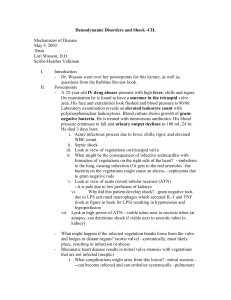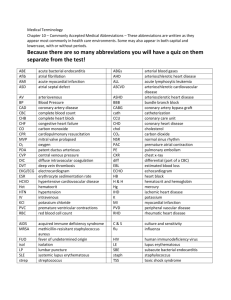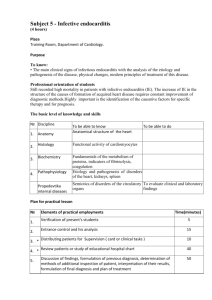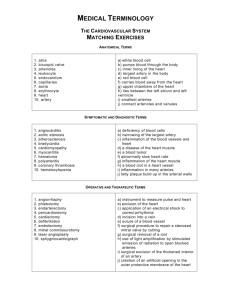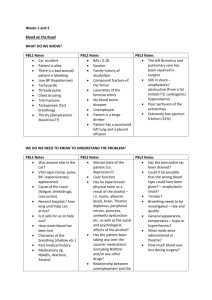Mitral valve infective endocarditis following Victor Grech, Joseph DeGiovanni
advertisement
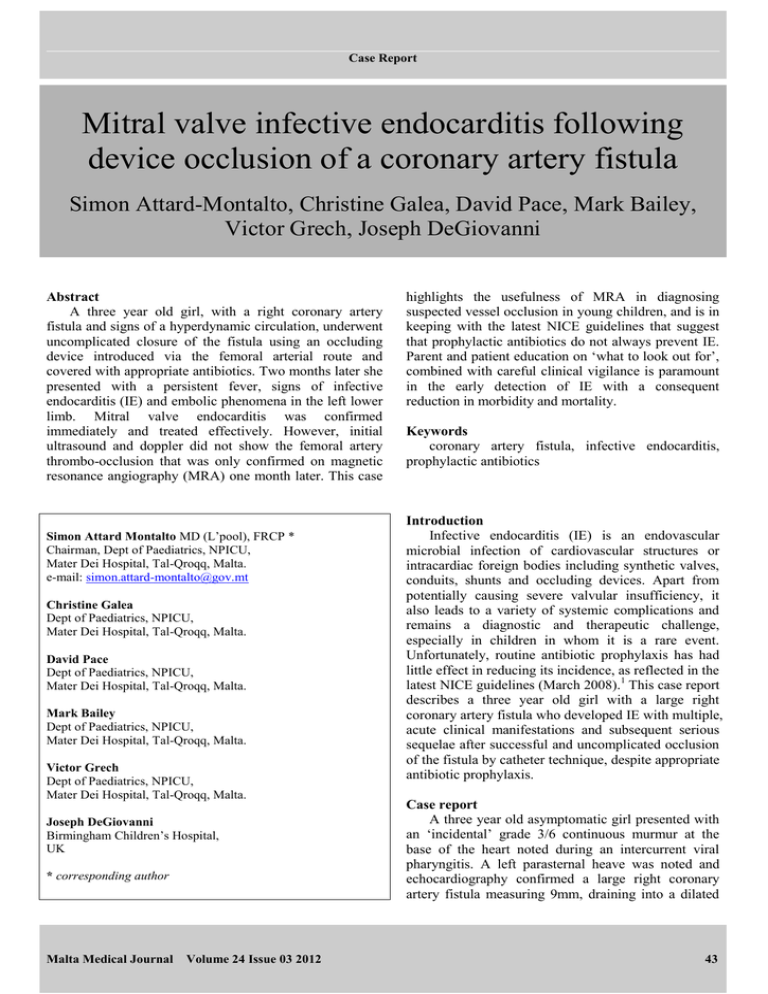
Case Report Mitral valve infective endocarditis following device occlusion of a coronary artery fistula Simon Attard-Montalto, Christine Galea, David Pace, Mark Bailey, Victor Grech, Joseph DeGiovanni Abstract A three year old girl, with a right coronary artery fistula and signs of a hyperdynamic circulation, underwent uncomplicated closure of the fistula using an occluding device introduced via the femoral arterial route and covered with appropriate antibiotics. Two months later she presented with a persistent fever, signs of infective endocarditis (IE) and embolic phenomena in the left lower limb. Mitral valve endocarditis was confirmed immediately and treated effectively. However, initial ultrasound and doppler did not show the femoral artery thrombo-occlusion that was only confirmed on magnetic resonance angiography (MRA) one month later. This case Simon Attard Montalto MD (L’pool), FRCP * Chairman, Dept of Paediatrics, NPICU, Mater Dei Hospital, Tal-Qroqq, Malta. e-mail: simon.attard-montalto@gov.mt Christine Galea Dept of Paediatrics, NPICU, Mater Dei Hospital, Tal-Qroqq, Malta. David Pace Dept of Paediatrics, NPICU, Mater Dei Hospital, Tal-Qroqq, Malta. Mark Bailey Dept of Paediatrics, NPICU, Mater Dei Hospital, Tal-Qroqq, Malta. Victor Grech Dept of Paediatrics, NPICU, Mater Dei Hospital, Tal-Qroqq, Malta. Joseph DeGiovanni Birmingham Children’s Hospital, UK * corresponding author Malta Medical Journal Volume 24 Issue 03 2012 highlights the usefulness of MRA in diagnosing suspected vessel occlusion in young children, and is in keeping with the latest NICE guidelines that suggest that prophylactic antibiotics do not always prevent IE. Parent and patient education on ‘what to look out for’, combined with careful clinical vigilance is paramount in the early detection of IE with a consequent reduction in morbidity and mortality. Keywords coronary artery fistula, infective endocarditis, prophylactic antibiotics Introduction Infective endocarditis (IE) is an endovascular microbial infection of cardiovascular structures or intracardiac foreign bodies including synthetic valves, conduits, shunts and occluding devices. Apart from potentially causing severe valvular insufficiency, it also leads to a variety of systemic complications and remains a diagnostic and therapeutic challenge, especially in children in whom it is a rare event. Unfortunately, routine antibiotic prophylaxis has had little effect in reducing its incidence, as reflected in the latest NICE guidelines (March 2008).1 This case report describes a three year old girl with a large right coronary artery fistula who developed IE with multiple, acute clinical manifestations and subsequent serious sequelae after successful and uncomplicated occlusion of the fistula by catheter technique, despite appropriate antibiotic prophylaxis. Case report A three year old asymptomatic girl presented with an ‘incidental’ grade 3/6 continuous murmur at the base of the heart noted during an intercurrent viral pharyngitis. A left parasternal heave was noted and echocardiography confirmed a large right coronary artery fistula measuring 9mm, draining into a dilated 43 Case Report right ventricle (Figure 1) with slightly reduced left ventricular function. This was occluded using an Amplatzer Medical 6mm vascular plug inserted via a 6F guiding catheter in the left femoral artery (Figure 2), and occlusion was confirmed by echocardiography and disappearance of the murmur. The patient was perfectly healthy and afebrile at the time of the interventional procedure that was complicated by difficulty gaining access via a right sided approach (i.e. right atrium via the femoral vein), necessitating a left sided approach retrogradely up the aorta via the left femoral artery. The procedure was covered with two doses of heparin and three doses of intravenous cefuroxime given peri-procedure and up to 16 hours later. She was started on aspirin daily thereafter. Both femoral pulses were equally palpable post-procedure. She developed a single spike of fever to 38oC six hours after the procedure that settled with paracetamol. On review two weeks later, she was well and afebrile, without any murmurs and good femoral pulses. Her haemoglobin had increased to 9.1g/dl from 8g/dl after the catheter procedure, and in view of haematological evidence of iron deficiency, she was started on iron supplementation. Two months later, she developed a fluctuating fever rising to 38.5oC over a period of ten days without an overt focus, followed by increasing pallor, palmar and plantar erythema, a macular rash over the left thigh and painful, erythematous patches consistent with Janeway lesions on the soles of her feet (Figure 3), with painful, bluish discolouration of the toes (especially left fourth toe, Figure 4). Figure 1: Coronary fistula from right coronary artery into right ventricle Legend: A=aorta; B=grossly dilated right coronary artery (9mm); C=normal left coronary artery; RA=right atrium; LA=left atrium; RV=right ventricle. Figure 3: Plantar erythema with Janeway lesions Figure 2: RCA Amplatzer occluding device (arrowed) seen behind right atrium Figure 4: Ischaemic changes in fourth left toe Malta Medical Journal Volume 24 Issue 03 2012 44 Case Report She had developed a limp due to pain in the left groin associated with an absent left femoral pulse and poorly palpable distal pulses on this side. In addition, she had clubbing of the fingers and toes, and a new grade 2/6 pansystolic murmur (PSM) at the apex of the heart. Splinter haemorrhages and hepatosplenomegaly were absent. Investigation confirmed a haemoglobin of 8.9g/dl, white count of 8.9 x 109/l, platelets 294 x 109/l, CRP 72g/l and normal renal and liver function. Mild cardiomegaly on chest X-ray due to a dilated left ventricle was noted but unchanged from earlier X-rays. Echocardiography confirmed persistent closure of the original fistula, but also showed large vegetations on the posterior mitral valve (MV) leaflets measuring 14x9mm and thickening of the anterior leaflet with significant mitral regurgitation (Figure 5). Repeated ultrasound and doppler studies performed by different experienced operators failed to identify any circulatory occlusion in the left lower limb. Enalapril, 3mg daily, was commenced. Blood cultures grew Streptococcus oralis that responded to teicoplaninand ceftriaxoneadministered intravenously through a Hickman line inserted into the right atrium, as well as rifampicin taken over a twelve week period. The indwelling line was inserted after an initial treatment period of 11 days when the patient was afebrile, with a normal white cell count and C reactive protein level so as to prevent infection of the line. starting antibiotics. Repeat blood cultures were negative. Doppler now confirmed a 15-20mmHg pressure difference in the lower limbs, whilst ultrasound and magnetic resonance angiography (MRA) scanning confirmed a large 4.83cm thrombus with occlusion in the left main femoral artery (Figure 6). An urgent femoral thrombectomy was performed in Birmingham Children’s hospital in the UK, whereby an infected organised thrombus was removed and the femoral artery repaired using a venous graft, followed by an excellent clinical recovery. She was initially treated with enoxaparin, folic acid and iron supplements as well as regular enalapril and aspirin that were maintained long term. Although well four months later with good left lower limb pulses and equal lower limb pressures, echocardiography still showed MV vegetations, albeit smaller, with moderate MV incompetence. At six months follow up, significant mitral and slight aortic regurgitation persisted, raising the possibility of further operative repair and possible MV replacement in the future. However, by 10 months there were no further vegetations with trivial aortic and moderate mitral incompetence on echocardiogram (ECHO). Figure 5: Large vegetations on the mitral valve Nevertheless, despite rapid abolition of the fever, resolution of painful nodules and steady improvement in distal pulses, the patient continued to complain of pain in the left groin and refused to weight bear one month after Malta Medical Journal Volume 24 Issue 03 2012 Figure 6: Occluding thrombo-embolus in left femoral artery (arrowed) 45 Case Report Discussion Coronary artery fistulae are rare congenital defects, amounting to less than 0.05% of all cardiac anomalies that, if untreated, will result in ventricular failure and carry a risk of infective endocarditis (IE).1,2 They may require surgical closure or may be amenable to occlusion by catheter techniques using Amplatzer or similar occluding devices, as employed in this case 2, although these procedures themselves carry a risk of IE.3,4 Successful deployment of the device generally requires the establishment of a guidewire loop via a femoral venous approach but, as in this case, failure to do so may necessitate an arterial ‘retrograde’ approach with the occluding device being delivered via the aorta. With both approaches, the left side of the heart is not accessed and the mitral valve not involved. Nevertheless, and despite prolonged cover with an appropriate antibiotic for 16 hours post procedure, this child still developed IE with Strep. oralis on the mitral valve two months later. Strep. oralis may have been introduced as a result of bacteraemia from the oral cavity during tracheal intubation, or via contamination with oral secretions from one of the operators or one of the many observers present in the catheter lab. However, since the Strep. oralis was sensitive to cefuroxime, the appropriate doses of this antibiotic administered during and after the catheter procedure should have prevented . The lengthy time interval of two months from procedure to IE also argues against this causal relationship. Alternatively therefore, bacteraemia could have occurred later during routine brushing of teeth with endocarditis settling on an area of endothelial damage on the mitral valve although how this occurred is not clear since the left side of the heart was not entered and the mitral valve was seen to be normal on earlier echocardiography. Finally, had the infection been introduced via an infected occluding device, it would have been almost impossible to achieve bacterial control and sterility with antibiotics alone and without removal of the device. The patient subsequently presented with a constellation of clinical signs suggestive of bacterial endocarditis5 with associated embolic phenomena and impaired circulation in the left lower limb. Despite several attempts to confirm thrombocclusion of the left femoral artery by ultrasound and doppler studies, this was not confirmed until an MRA was carried out by which time the thrombus was significantly organised and had to be removed by a specialist paediatric vascular surgical team in the UK. Earlier recourse to MRA may well have enabled an easier and earlier intervention when the risk of complications including femoral vessel rupture would have been considerably less. Indeed, this case highlights the usefulness of MRA in diagnosing suspected vessel occlusion in young children. Malta Medical Journal Volume 24 Issue 03 2012 This case also highlights the necessity of a prolonged course of effective antibiotics in order to render infective vegetations sterile6,7 and, as in this case, for conservative valvular healing thereby avoiding the need for open surgical repair or valve replacement. Infective endocarditis, although rare, is a lifethreatening complication of invasive cardiac procedures with a 20% mortality and, until recently, was believed to be preventable with the use of prophylactic antibiotics given routinely to cover high risk lesions and procedures.8-10 Current research, however, has estimated that only 6% of cases of IE may be prevented by prophylaxis.10 This low rate needs to be offset against the risks of adverse reactions to the antibiotics, the development of antibiotic resistance and the cost incurred. Consequently, several authoritative bodies including the American Heart Association11,12 and the latest NICE guidelines (March 2008)1 no longer recommend routine antibiotic prophylaxis for patients at risk of IE because, as highlighted by this case, they do not always prevent infection. Indeed, the latest guidelines suggest that prophylactic antibiotics should no longer be used routinely and reserved for particularly high risk cases. Patients at risk of IE should therefore be strongly advised on the importance of oral hygiene, often the source of any bacteraemic process, and any dental problems addressed before any invasive cardiac procedure, wherever possible. In addition, families and patients must be alerted to the risks of any invasive procedures (including body piercing and tattooing), and symptoms of IE so as to seek timely expert advice.1 This approach, combined with careful clinical vigilance is paramount in the early detection of IE that, in turn, will lead to a reduction in endocardiac and valvular damage and a better prognosis. Acknowledgement We are very grateful to the parents of this child who provided written consent to allow publication, and Mr Malcolm Sims, Consultant Vascular Surgeon, Birmingham Children’s Hospital, who performed the thrombectomy and femoral vein repair. References 1. 2. 3. Antimicrobial prophylaxis against infective endocarditis. National Institute for Health and Clinical Excellence. Clinical guidelines CG64. Issued March 2008. http://www.nice.org.uk/nicemedia/live/11938/40039/40039.pdf Said SA, Lam J, van der Werf T. Solitary coronary artery fistulas: a congenital anomaly in children and adults. A contemporary review. Congenit Heart Dis. 2006;1(3):63-76. Scheuerman O, Bruckheimer E, Marcus N, Hoffer V, Garty BZ. Endocarditis after closure of ventricular septal defect by transcatheter device. Pediatrics. 2006;117(6): e1256-8. 46 Case Report 4. 5. 6. 7. 8. 9. Apitz C, Ambrock C, Roller R, Kaulitz R, Sieverding L, Schmelz M, Hofbeck M. Bacterial endocarditis of a recanalized WaterstonCooley anastomosis: Interventional transcatheter occlusion with an Amplatzer-ASD occluder. Clin Res Cardiol. 2007;96(1): 51-5. Eble BK, Reyes G. Bacterial endocarditis. eMedicine Paediatrics: Cardiac Disease and Critical care. Nov 2009. http://emedicine.medscape.com/article/896540. Capitano B, Quintiliani R, Nightingale CH, Nicolau DP. Antibacterials for the prophylaxis and treatment of bacterial endocarditis in children. Paediatr Drugs. 2001;3(10):703-18. Brook MM. Pediatric bacterial endocarditis. Treatment and prophylaxis. Pediatr Clin North Am. 1999;46(2):275-87. Venugopalan P, Worthing EA. Infective endocarditis prophylaxis in children. Hosp Med. 1998;59(9):685-9. Dajani AS, Taubert KA, Wilson W, Bolger AF, Bayer A, Ferrieri P, et al. Prevention of bacterial endocarditis. Circulation. 1997;96:35866. Malta Medical Journal Volume 24 Issue 03 2012 10. Shanson D. New British and American guidelines for the antibiotic prophylaxis of infective endocarditis: do the changes make sense? A critical review. Curr Opin Infect Dis. 2008 Apr; 21(2): 191-9. 11. Wilson W, Taubert KA, Gewitz M, Lockhart PB, Baddour LM, Levison M, et al. Prevention of infective endocarditis: guidelines from the American Heart Association: a guideline from the American Heart Association Rheumatic Fever, Endocarditis, and Kawasaki Disease Committee, Council on Cardiovascular Disease in the Young, and the Council on Clinical Cardiology, Council on Cardiovascular Surgery and Anesthesia, and the Quality of Care and Outcomes Research Interdisciplinary Working Group. Erratum in: Circulation. 2007;116(15):e376-7. 47


